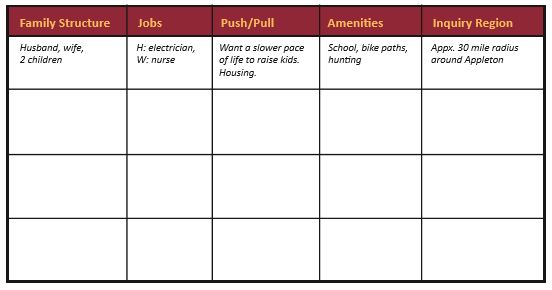Is Rural America Dying? Brain Gain, Motives and Interests of Newcomers
Part 7 of Brain Gain, Rewriting the Rural Narrative by Ben Winchester, U of M
By Marijo Vik www.normancountynewsonline.com
Strategy: Engage with real estate agents and property owners to track motivations and interests of newcomers.
These housing agents are on the front lines of potential newcomer connections and can track the “pulse” of new migrants to the region. The benefits of this engagement serve the interests of both the regional recruitment team as well as the agents themselves.
A “Realtor Reflection Work Sheet” could provide basic information about those people looking to move into the region. Push includes reasons they are leaving their current location, and Pull includes reasons they are moving to our region. The Inquiry Region indicates how wide of a “net” they are casting when they look for a new home. See the sample form.

Employment Strategies
Strategy: Build upon existing connections to metropolitan businesses that are allowing skilled employees to telecommute from rural Minnesota.
In rural Minnesota we are witnessing a migration of newcomers with employment by a metropolitan employer. Computer programmers, writers, editors, and others were identified through the survey. Additional interviews would need to be conducted to determine the breadth of companies that could be engaged in development.
These niche occupations provide an opportunity to build knowledge clusters in the prairie, serving both business needs and employee quality of life requirements. Discussions should be held with these employers to determine models of economic development cooperation. We now find that economic development may need to occur proactively outside of the immediate area. However, this is not a “shot in the dark” approach as there are existing connections and proven success that can drive future growth.
Strategy: Identify and build upon auxiliary skills of newcomers.
Many of the new residents have left an occupation or high-skill employment situation that is not required in their new setting. Survey results indicate this disconnect between the human capital (education, skills and training) of the newcomers and the reality of their employment situation. By explicitly engaging these new residents to discuss the skills sets they may have left behind, there are opportunities to not only further engage newcomers economically, but to diversify the overall economy of the region.
Strategy: Disseminate the model of regional recruitment to local decision makers.
This model will describe the investment required, and the return on that investment, to support newcomer strategies. The intermingling of social and economic decisions made by newcomers is not necessarily recognized by decision makers of economic development agencies. The increased mobility of employees and workplaces does require a rethinking by those bound in the traditional model of industrial attraction.
The economic impact analysis completed by Brigid Tuck does provide data regarding this return, and it is significant. The analysis should be presented to decision-makers in the region.
Strategy: Integrate business succession planning.
There were a surprisingly high number of newcomers that were self-employed or small businesses owners after their move. These economic opportunities offer great potential for business succession planning efforts. The aging of established business owners is not a new trend for rural Minnesota. As the businesses are not necessarily “on the market” they can be difficult to locate without living in the community. The engagement of these businesses owners can provide a pool of opportunity that would further enhance a recruitment model.
Newcomer Support Strategies
It was found that newcomers may have difficulty connecting to the local social infrastructure. Therefore, a strategy dedicated to supporting newcomers soon after they make the move is recommended.
Strategy: Emphasize newcomers among regional partner agencies.
This committee would connect local and regional development agents to better serve those moving to the region. This includes city clerks, EDA representatives, housing agents, school administrators, as well as real estate and property management agents. This committee would be responsible for not only coordinating their response to newcomer inquiries described earlier, but would also provide a source of support for small towns that are interested in developing support mechanisms.
These include welcome wagons (in person and online) as a first point of contact and activities/events for younger residents in town to get to know one another.
The focus groups found that while newcomers expected the community to be composed of older residents, they were surprised that there were so many young people (age 30-45) in town. The focus groups themselves proved to be a valuable opportunity for these unconnected newcomers to connect.
In Montevideo, a young professionals group has been formed following the focus group. The Ortonville Independent newspaper has started a series highlighting residents who have moved to town.
Additional Thoughts
Winchester provided data specific to the counties of Norman, Polk and Red Lake.
Previous data showed that population losses are driven mostly by losses of high school graduates. This is especially evident in Red Lake County where there's a 5 percent loss in population between 2000 and 2010, but a 1 percent gain in occupied housing units. This means those moving out were generally not homeowners and those moving in are homeowners.
Data show that 70 percent plus of the homes are owned by baby boomers and older. Put another way, 70 percent of the homes will be on the market over the next 20 years.
Are those homes ready to sell? Are there opportunities for these seniors to "move over" to another form of housing that may be lower maintenance? We're not talking about continuum of care stuff, but just the next phase of housing.
As we open up this housing supply it will also open the door to more newcomers moving in.
The demand for leadership is especially high in Norman and Red Lake counties. Here, 1 in 13 and 1 in 15 (respectively), adults need to be involved in a leadership position within the nonprofit and government sectors.
There's been great growth in nonprofit assets and revenues in all the counties - growth exceeding the rate of inflation.
###
